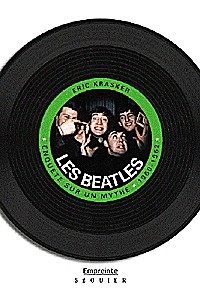 |
THE BEAR FAMILY POLYDOR BOX SET: by Eric Krasker (Paris) © Eric Krasker 2002 |
 |
 |
THE BEAR FAMILY POLYDOR BOX SET: by Eric Krasker (Paris) © Eric Krasker 2002 |
 |
|
As the author of the forthcoming book The Beatles: Investigation of a Myth (1960-62)* which will contain an important chapter dealing with Tony Sheridan and The Beatles, I would like to make some comments on the new Bear Family release, entitled The Beatles with Tony Sheridan - Beatles Bop - Hamburg Days. It comes either as a deluxe LP sized box set containing two CDs plus a book (BCD 16447 BK), or as a regular double CD (BCD 16583 BH). Of course, the box looks beautiful, and the impressive book inside whose text was written by Hans Olof Gottfridsson features some very interesting documents: Apart from a collection of Polydor logs, we can find previously unpublished photos of the group in the Star-Club (coming from the Hamburg photo archivist Ulf Krüger), wonderful colour photos of record covers from different countries, a reproduction, in colour, of the very first contract in German between Bert Kaempfert and the Beatles, and especially these 4 handwritten Beatles CVs that surfaced only recently from Doris Kaempfert's archives. As far as the music is concerned, at last a record label had the good sense (based on an original idea from the German music journalist and author Bernd Matheja) to issue on one double CD all the available variations of the 8 familiar basic tracks - mono & stereo mixes, US versions, medley versions etc. - the Beatles made for Polydor, and the sound quality of the records is superb, as you would expect from Bear Family products. With regard to historical facts now, some pieces of information from the Polydor archives are, at last, interpreted more precisely in the Bear Family book. For instance, it will henceforth be clear to everybody that the 1962 recording session with the Beatles and Tony Sheridan was made in two different stages, a decision which was very unusual in those days. In fact, on May 24, 1962 only the backing tracks (Playback) of the two songs Sweet Georgia Brown and Swanee River were recorded in studio Rahlstedt (Wandsbek) with the Beatles and Roy Young on piano, whereas Tony Sheridan came back there two weeks later, on June 7, 1962, to record the vocals (Synchronisation). (For historical accuracy, it must be stated, though, that this small but important observation is not really a scoop. It was revealed - among others - twice before in German fan-club magazines: first in an article written by Thorsten Schmidt, entitled "Was machten die Beatles am 24. Mai 1962?" ["What were the Beatles doing?], published in Beatlemania # 79 (July/August 1997), and in another one by Thorsten Knublauch, entitled "Die Polydor Aufnahmen" ["The Polydor Recordings"], in A ticket to write, in autumn 1998). All this clearly explains now why it was possible in January 1964 for producer Paul Murphy to make the "doctored" version of Sweet Georgia Brown - which is familiar to every average Beatle fan - by simply re-using the original playback of the song that was not thrown away by Kaempfert after the recording sessions of May/June1962. However, as for the identity of the only surviving version of Swanee River, the situation remains rather odd and confusing:
All this shows that the situation is not at all clear, neither for the committed historian nor for the average consumer. So, as complete as it appears to be, the Bear Family product doesn't bring a definitive conclusion to this important and much debated chapter of the Beatles' history, and some important questions are still left to be answered. As I was working on the Sheridan/Beatles 1962 recording sessions and investigating on the Swanee River myth more closely (a myth born as early as 1986 in Mark Lewisohn's book The Beatles, Live!), I realized I absolutely needed to clarify the exact circumstances of the recording and the release of that enigmatic LP My Bonnie (which features the only surviving version of Swanee River) first if I wanted to get the key to the whole explanation. So, in 1999 I re-interviewed Tony Sheridan, then I went to Germany, got in touch with different people, and eventually found all the Polydor archive material and technical information I needed to solve the problem. Some of them were documents Gottfridsson said himself he had in his possession but did not publish in his first book, most probably because they were too embarrassing for his theory. Others were completely new Polydor logs that I was given first hand and which are not even published in the Bear Family book either. Thus, I could precisely reconstruct, date after date, the genesis of the My Bonnie LP (the first one on which the Beatles are featured), from its recording in December 1961 to its official release in the spring of 1962. At last, thanks to an unbroken chain of evidence based on the documents I gathered, most of which are previously unpublished, everybody will understand on what grounds the Swanee River myth was constructed, and how easy it was to avoid as early as 1997!! By the way, my book - which will be published in French and in English around the spring 2003 - will also include a complete chapter dealing with the not less mysterious Star-Club tapes. It contains some surprising and unexpected (and somewhat unpleasant, too) information, but that's another story altogether. * In 2009 an English version of the book was released. The title of the book changed in its translation to "The Beatles Fact and Fiction 1960 - 1962." To order Eric Krasker's excellent book in English text, please click here. To order Eric Krasker's excellent book in French text, please click here.
|